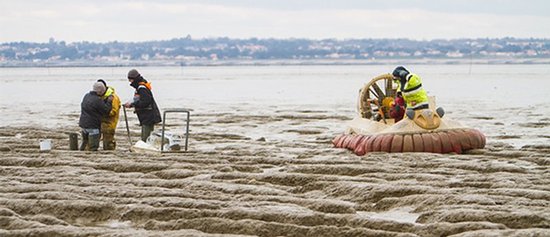Biodiversity and coastal environment
Axis 1

Fieldwork at the Baie of Bourgneuf - March 2013 (photo credits : Laurent Barillé)
Microalgae are the primary producers of both pelagic and benthic food webs. They also play an important role in the coastal ecosystem, which is complex and comprises numerous interactions between organisms and the physico-chemical factors. Microalgae are taken up by filter-feeders like bivalves and represent a significant part of their diet. However, anthropogenic pressures are impacting these coastal ecosystems with changing biomass and community structures of algae. For example, the proliferation of toxic microalgae in the pelagic compartment may accumulate in edible species and pose a threat to public health. In the benthic compartment, populations of microalgae found in mud flats are called microphytobenthos. These populations have been described but their functional role and their interactions with the numerous links of the ecosystem have yet to be understood. Whether it is about microalgae found in the water column or in mudflats and microphytobenthic species, our project’s aim is to emphasise the functional dimension of these organisms: trophic role, toxin-production, biotic interactions (allelopathy, links with invasive species like the wild oysters) and abiotic interactions (links with the nutrient flux).
For the benthic compartment, the role of factors that structure the populations of microalgae is controversial, and in particularly that of nutrients. We thus suggest estimating and analysing the dynamics of primary production at the working site of Bourgneuf Bay. We will study the trophic and spatial interactions between wild oyster reefs and microalgae in the sediment, the diversity of benthic organisms that depend on theses interactions and the limicoline birds. Areas not under the influence of wild and cultivated oysters will also be studied. Laboratory work will be carried out to understand processes like autotrophy and heterotrophy in microalgae and their influence on population diversity. Moreover, we wish to bring an additional dimension through social and human sciences with two concepts. Firstly, the concept of ordinary biodiversity (species which do not have any protected status) characterises most of the organisms which we will be studying in the benthic compartment. Secondly, the concept of invasive species and their situation with regard to the law, by addressing the great principles of environmental laws and the laws of the sea. The risk of invasion of European coasts by wild oysters is an international concern and we aim to carry out our research work on microalgae with regard to this phenomenon.
Regards microalgae from the pelagic phytoplankton, we will examine the diversity and function of food webs of toxic algae. Toxins synthesised by the dinoflagellate Dinophysis sp. and the diatom Pseudo-Nitzschia sp., can accumulate in the digestive glands of bivalve mollusks and cause intoxications such as diarrhea and amnesia in human beings. Bans on the sales of shellfish have important socio-economic repercussions. This project’s objective is to determine the environmental factors that cause the toxicity in Pseudo-nitzschia sp. and the influence of those factors on the relationship between toxicity and mixotrophy in Dinophysis sp. The approach used includes culture experiments and statistical analysis of data obtained in situ on the concerned organisms. The biodiversity of an environment is also comprised of the chemical diversity of the organisms or of the entire system. This chemo-diversity will be studied with the help of metabolomic tools which will be developed through high resolution mass spectrometry techniques, passive sampling and the screening of data banks on all marine natural compounds. As a result, these techniques will help to evaluate the threats posed by the metabolites of bioactive algae like phycotoxins.
Axis Coordinators : Laurent Barillé, Université de Nantes, Emmanuelle Geslin, Université d’Angers & Philipp Hess, Ifremer.